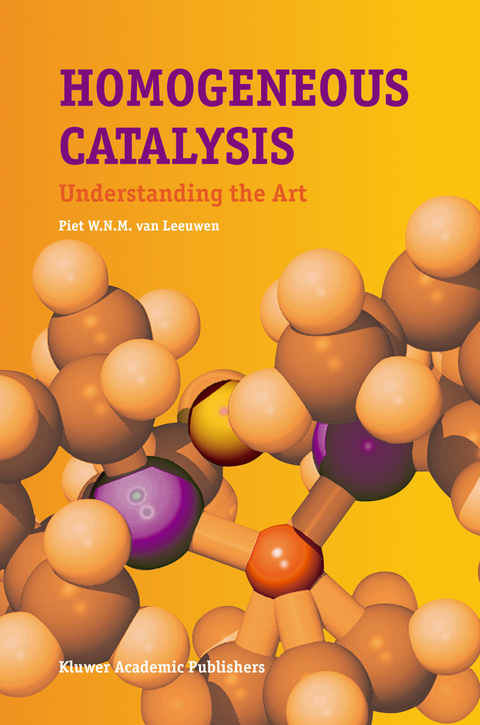
Homogeneous Catalysis
Understanding the Art
Seiten
2005
Springer-Verlag New York Inc.
978-1-4020-3176-2 (ISBN)
Springer-Verlag New York Inc.
978-1-4020-3176-2 (ISBN)
Homogeneous catalysis using transition metal complexes is an area of research that has grown enormously in recent years. Many amazing catalytic discoveries have been reported by researchers both in industry and in academia.
Homogeneous Catalysis: Understanding the Art gives real insight in the many new and old reactions of importance. It is based on the author's extensive experience in both teaching and industrial practice. Each chapter starts with the basic knowledge and ends with up-to-date concepts.
The focus of this book is on concepts, but many key industrial processes and applications that are important in the laboratory synthesis of organic chemicals are used as examples. The full range of topics is covered, such as fine chemicals, bulk chemicals, polymers, high-tech polymers, pharmaceuticals, but also important techniques and reaction types among other aspects. For a few reactions the process schemes, environmental concerns and safety aspects are included, to encourage catalyst researchers to think about these topics at an early stage of their projects and to communicate with chemical engineers, customers and the end-users.
Homogeneous Catalysis: Understanding the Art provides a balanced overview of the vibrant and growing field of homogeneous catalysis to chemists trained in different disciplines and to graduate students who take catalysis as a main or secondary subject. This book is an invaluable tool for practising professionals and academia, including:
Chemists in academia with an inorganic, organic, catalytic, etc., chemistry background;
PhD-students in these fields, and advanced students;
Research Institutes of Petrochemical industries;
Fine-chemical industries;
Pharmaceutical industries;
Chemical Laboratories of Universities for Organic, Industrial, Inorganic, and Physical Chemistry, and Catalysis;
Graduate schools.
Currently, there is no other book available that gives insight into so many reactions of importance, while the field of homogeneous catalysis is becoming more and more important to organic chemists, industrial chemists, and academia. This book will provide this background to chemists trained in a different discipline and graduate and masters students who take catalysis as a main or secondary topic.
Homogeneous Catalysis: Understanding the Art gives real insight in the many new and old reactions of importance. It is based on the author's extensive experience in both teaching and industrial practice. Each chapter starts with the basic knowledge and ends with up-to-date concepts.
The focus of this book is on concepts, but many key industrial processes and applications that are important in the laboratory synthesis of organic chemicals are used as examples. The full range of topics is covered, such as fine chemicals, bulk chemicals, polymers, high-tech polymers, pharmaceuticals, but also important techniques and reaction types among other aspects. For a few reactions the process schemes, environmental concerns and safety aspects are included, to encourage catalyst researchers to think about these topics at an early stage of their projects and to communicate with chemical engineers, customers and the end-users.
Homogeneous Catalysis: Understanding the Art provides a balanced overview of the vibrant and growing field of homogeneous catalysis to chemists trained in different disciplines and to graduate students who take catalysis as a main or secondary subject. This book is an invaluable tool for practising professionals and academia, including:
Chemists in academia with an inorganic, organic, catalytic, etc., chemistry background;
PhD-students in these fields, and advanced students;
Research Institutes of Petrochemical industries;
Fine-chemical industries;
Pharmaceutical industries;
Chemical Laboratories of Universities for Organic, Industrial, Inorganic, and Physical Chemistry, and Catalysis;
Graduate schools.
Currently, there is no other book available that gives insight into so many reactions of importance, while the field of homogeneous catalysis is becoming more and more important to organic chemists, industrial chemists, and academia. This book will provide this background to chemists trained in a different discipline and graduate and masters students who take catalysis as a main or secondary topic.
Elementary Steps.- Kinetics.- Hydrogenation.- Isomerisation.- Carbonylation of Methanol and Methyl Acetate.- Cobalt Catalysed Hydroformylation.- Rhodium Catalysed Hydroformylation.- Alkene Oligomerisation.- Alkene Polymerisation.- Hydrocyanation of Alkenes.- Palladium Catalysed Carbonylations of Alkenes.- Palladium Catalysed Cross-Coupling Reactions.- Epoxidation.- Oxidation with Dioxygen.- Alkene Metathesis.- Enantioselective Cyclopropanation.- Hydrosilylation.- C-H Functionalisation.
| Zusatzinfo | XIV, 408 p. |
|---|---|
| Verlagsort | New York, NY |
| Sprache | englisch |
| Maße | 160 x 240 mm |
| Themenwelt | Naturwissenschaften ► Chemie ► Anorganische Chemie |
| Naturwissenschaften ► Chemie ► Organische Chemie | |
| Naturwissenschaften ► Chemie ► Physikalische Chemie | |
| Technik | |
| ISBN-10 | 1-4020-3176-9 / 1402031769 |
| ISBN-13 | 978-1-4020-3176-2 / 9781402031762 |
| Zustand | Neuware |
| Haben Sie eine Frage zum Produkt? |
Mehr entdecken
aus dem Bereich
aus dem Bereich


